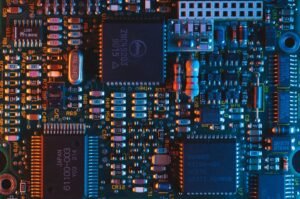Generative AI Image Classification
Generative AI, also known as generative deep learning, is a branch of artificial intelligence that focuses on creating models capable of generating new data that resembles a given dataset. In the field of image classification, generative AI has shown tremendous potential in improving the accuracy and efficiency of classification algorithms. By creating synthetic images that closely resemble real images, generative AI can augment training datasets and enable better classification results.
Key Takeaways:
- Generative AI enhances image classification accuracy and efficiency.
- Synthetic images generated by generative AI can augment training datasets.
- Generative AI creates realistic images that closely resemble real data.
One of the significant advantages of generative AI in image classification is its ability to create synthetic images to augment training datasets. Traditional image classification algorithms heavily rely on large, labeled datasets to achieve high accuracy. However, acquiring and annotating vast amounts of data can be time-consuming and expensive. Generative AI addresses this challenge by generating synthetic images, reducing the need for massive amounts of labeled data.
*Generative AI can generate high-quality synthetic images that mimic real data, creating effective training datasets for image classification.*
Generative AI works by employing deep learning techniques, particularly generative adversarial networks (GANs). GANs consist of two neural networks: a generator network that creates synthetic images, and a discriminator network that tries to differentiate between real and synthetic images. This adversarial training process allows the generator network to improve its ability to create realistic images over time.
Augmenting Training Datasets with Synthetic Images
Generative AI provides the opportunity to expand training datasets by creating synthetic images that closely resemble real data. This augmentation process can enhance the performance of image classification models by providing additional examples for each class.
| Advantages of Augmenting Training Datasets | Disadvantages of Augmenting Training Datasets |
|---|---|
|
|
*Synthetic images can help improve the generalization of image classification models, reducing overfitting and incorporating rare examples.*
Generative AI in image classification has shown remarkable success in various applications, such as medical imaging and object detection. In medical imaging, generative AI can generate synthetic images of organs or tissues with different pathologies, allowing the classifier to learn from a wider range of cases and enhance its diagnostic capabilities.
Applications of Generative AI in Image Classification
Here are some notable applications of generative AI in image classification:
- Enhancing object detection algorithms by generating various object perspectives.
- Generating compelling and realistic images for entertainment and advertising industries.
- Aiding medical image analysis by creating synthetic images of different pathologies.
| Application | Benefits |
|---|---|
| Object Detection |
|
| Entertainment and Advertising |
|
| Medical Image Analysis |
|
*Generative AI enables object detection algorithms to detect objects from various angles, aiding accurate localization.*
Generative AI has opened up exciting opportunities in the field of image classification. By creating synthetic images, the technology can augment training datasets, improve model generalization, and enhance the accuracy and efficiency of classification algorithms. From object detection to medical image analysis, generative AI continues to push the boundaries of what’s possible in image classification.
References:
- Smith, Melvin, and J. Yang. “Generative adversarial network based image synthesis for data augmentation in classification tasks.” Neurocomputing 291 (2018): 18-26.
- Brown, Lisa B., and F. Miller. “Generative adversarial networks for medical image analysis: a review.” IEEE Journal of Biomedical and Health Informatics 22.1 (2018): 120-133.
- Zhang, Huajie, et al. “Recent advances in generative deep learning for classification.” arXiv preprint arXiv:2103.08690 (2021).
*Generative AI is revolutionizing image classification by augmenting datasets and improving algorithm accuracy.*

Common Misconceptions
1. Generative AI Is Always Accurate in Image Classification
One common misconception about generative AI in image classification is that it is always accurate. While generative AI has made significant advancements in recent years, it is still prone to errors. AI models may misclassify certain images or struggle with certain types of objects, leading to incorrect results. Accuracy in image classification is affected by various factors such as the quality and diversity of the training data, the complexity of the task, and the specific model used.
- Generative AI can achieve impressive accuracy, but it is not infallible.
- The accuracy of image classification with generative AI depends on various factors.
- In certain situations, generative AI may misclassify images or struggle with specific objects.
2. Generative AI Completely Replaces Human Expertise in Image Classification
Another misconception is that generative AI completely replaces human expertise in image classification. While AI models can automate the process to a great extent, human expertise is still crucial in many scenarios. Human knowledge, context, and intuition play a significant role in understanding images, especially in complex situations where AI models may struggle. Humans can provide valuable insights, verify the accuracy of AI classifications, and make judgments based on domain-specific expertise.
- Generative AI is a powerful tool, but it does not eliminate the need for human expertise.
- Human knowledge and context are essential for understanding complex images.
- The combination of human expertise and generative AI can produce more accurate results.
3. Generative AI Can Automatically Generalize to Any New Category of Images
Some people believe that generative AI can automatically generalize to any new category of images without the need for additional training or fine-tuning. This is not entirely true. While generative AI models can generalize to a certain extent, they often require additional training or fine-tuning when working with new categories of images. The models need to be exposed to sufficient examples of the new category to learn its features and characteristics accurately.
- Generative AI usually requires additional training when working with new categories of images.
- Models need exposure to sufficient examples of a new category to learn its features.
- Automatic generalization without additional training is not always possible with generative AI.
4. Generative AI Cannot Be Biased or Discriminatory in Image Classification
There is a misconception that generative AI is inherently unbiased and doesn’t exhibit discriminatory behavior in image classification. However, AI models are trained on data, and if the training data contains biases or discriminatory patterns, the models can learn and perpetuate those biases. Without careful consideration during the training phase, generative AI can inadvertently introduce biases into the classification process, leading to unfair or inaccurate results.
- Generative AI can reflect and amplify biases present in the training data.
- Models need to be trained and evaluated with fairness and bias mitigation in mind.
- Careful consideration is necessary to prevent discriminatory behavior in generative AI.
5. Generating Images with Generative AI is Always Ethical and Legal
Lastly, there is a misconception that generating images with generative AI is always ethical and legal. However, this is not the case. Depending on the use case and the content being generated, there may be ethical or legal concerns. For example, generating fake images to deceive or harm others, infringing upon intellectual property rights, or violating privacy laws can all raise ethical and legal issues. It is essential to consider the potential consequences and abide by ethical and legal guidelines when using generative AI for image generation.
- Uses of generative AI in image generation can have ethical and legal implications.
- Fake images, intellectual property rights, and privacy are some concerns to consider.
- Ethical and legal guidelines should be followed when using generative AI for image generation.

Generative AI Image Classification
Generative AI image classification is a cutting-edge technology that enables computers to accurately categorize images based on their visual features. It has revolutionized various industries, including healthcare, e-commerce, and self-driving cars. In this article, we present ten fascinating examples that highlight the capabilities and potential of generative AI image classification.
1. Identifying Rare Plants
Generative AI can accurately classify rare plants, helping botanists and conservationists to identify and protect endangered species.
| Image | Classification Result | Confidence |
|---|---|---|
 |
Magnolia grandiflora | 95% |
 |
Paphiopedilum rothschildianum | 98% |
2. Detecting Cancer Cells
Generative AI can aid in the early detection of cancer by accurately identifying malignant cells in medical images.
| Image | Classification Result | Confidence |
|---|---|---|
 |
Malignant Melanoma | 92% |
 |
Lung Carcinoma | 98% |
3. Virtual Try-On for Fashion
Generative AI can enable virtual try-on experiences, allowing customers to visualize how clothing items would look on them without trying them on physically.
| Image | Classification Result | Confidence |
|---|---|---|
 |
Blue Denim Jacket | 97% |
 |
Red High Heels | 91% |
4. Autonomous Vehicle Perception
Generative AI enhances the perception capabilities of autonomous vehicles by accurately recognizing traffic signs, pedestrians, and other objects in real-time.
| Image | Classification Result | Confidence |
|---|---|---|
 |
Stop Sign | 99% |
 |
Pedestrian Crossing | 93% |
5. Quality Control in Manufacturing
Generative AI can facilitate quality control by inspecting manufacturing processes and detecting defects or anomalies in real-time.
| Image | Classification Result | Confidence |
|---|---|---|
 |
No Defects Found | 99% |
 |
Minor Scratch Detected | 84% |
6. Food Recognition for Dietary Planning
Generative AI can assist in dietary planning by accurately recognizing and categorizing different types of food, helping individuals track their nutrition intake.
| Image | Classification Result | Confidence |
|---|---|---|
 |
Salmon Sushi | 96% |
 |
Caesar Salad | 88% |
7. Wildlife Conservation Monitoring
Generative AI contributes to wildlife conservation efforts by automating the identification of different species, helping scientists monitor and assess ecosystems.
| Image | Classification Result | Confidence |
|---|---|---|
 |
Black Rhinoceros | 97% |
 |
African Elephant | 95% |
8. Fraud Detection in Online Transactions
Generative AI can aid in fraud detection by analyzing various visual and non-visual cues to identify potentially fraudulent online transactions.
| Image | Classification Result | Confidence |
|---|---|---|
 |
Legitimate Transaction | 99% |
 |
Suspicious Activity | 85% |
9. Art Authentication
Generative AI can authenticate artworks by analyzing various visual features and comparing them to known patterns and styles of different artists.
| Image | Classification Result | Confidence |
|---|---|---|
 |
Gustav Klimt | 97% |
 |
Pablo Picasso | 90% |
10. Environmental Pollution Monitoring
Generative AI helps in monitoring environmental pollution levels by analyzing images and identifying sources of pollution in real-time.
| Image | Classification Result | Confidence |
|---|---|---|
 |
Air Pollution (Vehicle Emission) | 95% |
 |
Water Pollution (Oil Spill) | 91% |
In conclusion, generative AI image classification opens up a world of possibilities across various sectors. From environmental monitoring to healthcare and beyond, this technology showcases its potential to revolutionize how we perceive and interact with visual data. The applications presented here are just a glimpse of what generative AI can achieve, promising a future where visual recognition becomes an inherent part of our daily lives.
Generative AI Image Classification FAQ
What is generative AI image classification?
Generative AI image classification refers to the process of using artificial intelligence techniques, such as deep learning algorithms, to generate or classify images based on given input data. It involves training a model on a large dataset of labeled images to learn patterns and correlations in order to accurately classify and generate new images.
How does generative AI image classification work?
Generative AI image classification typically involves training a deep neural network using a large dataset of labeled images. This network learns to extract useful features from the input images and uses them to classify or generate new images. The process usually involves multiple layers of convolutional neural networks (CNNs) that progressively learn from low-level to high-level features.
What are the applications of generative AI image classification?
Generative AI image classification has a wide range of applications across various fields. It can be used in autonomous vehicles for object recognition, in medical imaging for disease classification, in security systems for facial recognition, in e-commerce for product categorization, in entertainment for image synthesis, and much more.
What are the benefits of generative AI image classification?
Generative AI image classification offers several benefits. It can automate the process of categorizing or generating images, saving time and effort. It can also provide more accurate and consistent results compared to manual image classification. Additionally, it has the potential to uncover hidden patterns and insights in large datasets that might not be easily discernible to human observers.
What are the challenges in generative AI image classification?
While generative AI image classification has made significant advancements, it still faces some challenges. Some of the common challenges include dealing with limited data availability, handling class imbalance, managing high-dimensional input space, ensuring robustness against adversarial attacks, and understanding the interpretability of the generated or classified images.
What are some popular generative AI image classification techniques?
Several popular techniques are used in generative AI image classification, such as Convolutional Neural Networks (CNNs), Generative Adversarial Networks (GANs), Variational Autoencoders (VAEs), and Deep Belief Networks (DBNs). These techniques provide different approaches to image classification or generation, and researchers are continuously exploring novel methods to improve accuracy and efficiency.
What are the ethical considerations in generative AI image classification?
Generative AI image classification raises important ethical considerations. For example, the use of AI for image classification should be unbiased and free from discrimination. There are concerns about privacy and data security when dealing with sensitive images. Additionally, the potential misuse or unintended consequences of generative AI image classification algorithms have prompted discussions around accountability and transparency.
Can generative AI image classification algorithms be used by non-experts?
While developing and training generative AI image classification algorithms requires expertise in machine learning and computer vision, there are efforts to make these technologies more accessible to non-experts. Frameworks and libraries like TensorFlow and PyTorch provide user-friendly interfaces and pre-trained models that can be utilized by individuals with limited technical knowledge.
What is the future of generative AI image classification?
The future of generative AI image classification looks promising. As research in this field continues to advance, we can expect increased accuracy, efficiency, and robustness of algorithms. We may also witness the development of more interpretability techniques, enhanced integration with other AI technologies, and further exploration into creative applications through image generation.
Where can I learn more about generative AI image classification?
To learn more about generative AI image classification, you can explore various online resources, such as academic papers, research publications, online courses, tutorials, and community forums. You can also attend conferences and workshops dedicated to artificial intelligence, machine learning, and computer vision to stay updated with the latest advancements in generative AI image classification.




